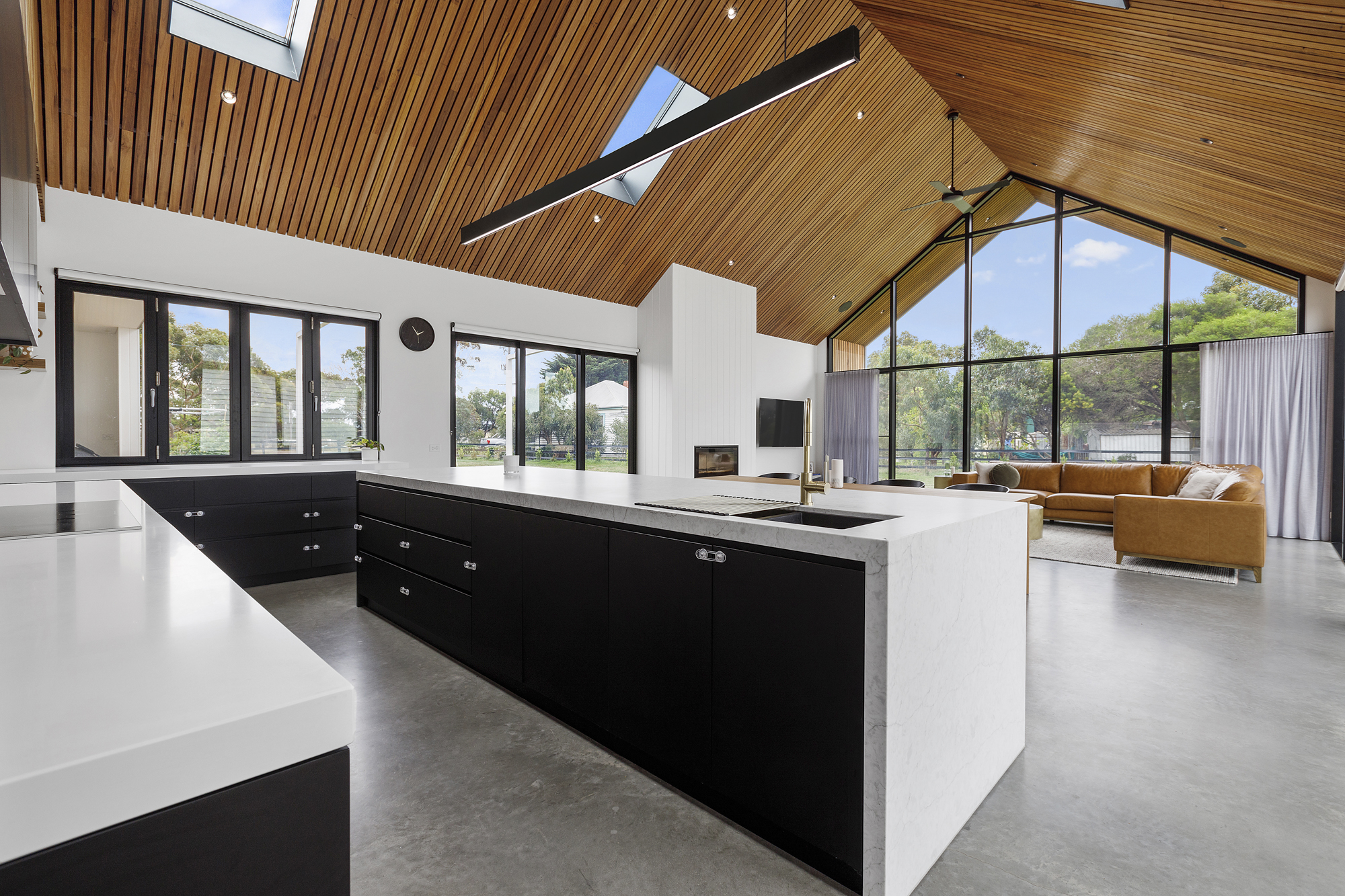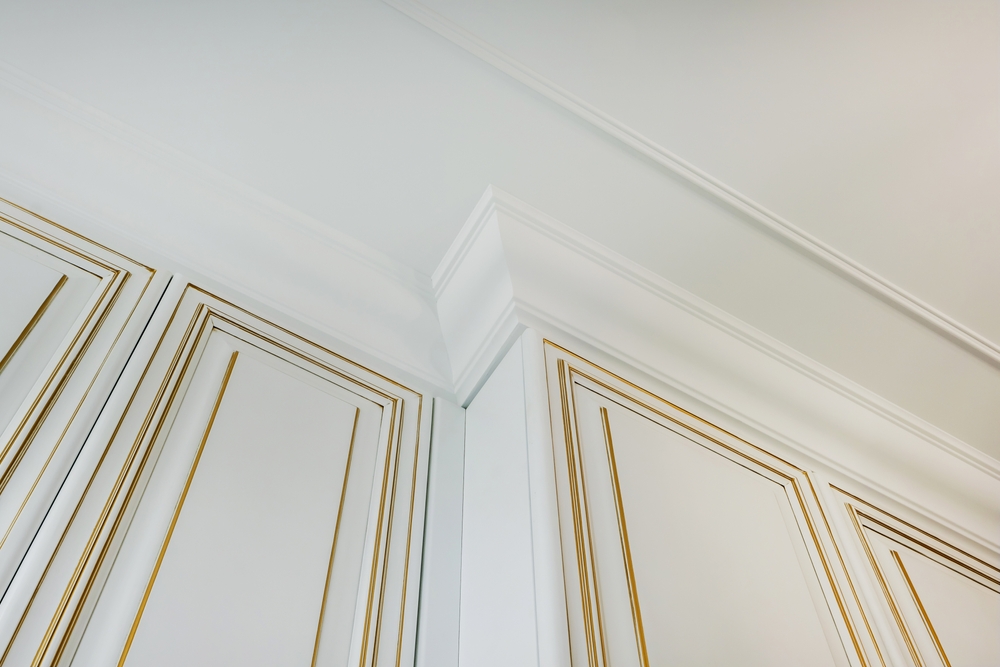10 Types of Ceilings to Choose From

When embarking on the journey of designing a building, one of the key architectural features to consider is the ceiling. With multiple types of ceilings available, choosing the perfect one can transform the aesthetic and atmosphere of a space.
Today, we delve into the world of ceiling styles, exploring everything from the classic to the contemporary. Whether you’re drawn to the common type that blends seamlessly with your design or you’re looking for something that makes a bold statement, we’ve got you covered. Join us as we lift our gaze upwards and unveil the ceiling styles that can redefine your interior space.
Flat ceilings

Flat ceilings are your conventional ceilings found in most residential properties. They are appreciated for their unassuming presence and their practicality, as they easily accommodate most types of lighting fixtures and are simple to paint or texture for aesthetic versatility.
Moreover, their straightforward design means they can be easily accessed for repairs and alterations, making them a practical choice for homeowners. The flat surface is also beneficial acoustically, as it doesn’t create the echoes or sound distortion that can sometimes occur with higher or more complex ceilings.
Tray ceilings

Tray ceilings, with their recessed multi-level design, introduce an architectural nuance to an otherwise standard ceiling. The inset portion, often accentuated with lighting, can create a soft ambient glow that enhances the room’s cosiness. This design can also be painted a different colour than the higher perimeter to add contrast or to draw the eye upwards, thus making the room appear taller and more spacious.
While more complex than a flat ceiling, the tray ceiling can add significant aesthetic value to a room, making it a popular choice for dining rooms, master bedrooms, or other areas where a touch of elegance is desired.
Cathedral ceilings

Cathedral ceilings, create a striking visual line that draws the eye upward, emphasising vertical space and grandeur. They’re especially effective in living rooms or great rooms where a sense of openness is desired. The high peaks of cathedral ceilings not only enhance the spaciousness of a room but also allow for large windows or skylights, which can flood the space with natural light.
However, this type of ceiling may require more heating in the winter or air conditioning in the summer due to the increased volume of the room.
Vaulted ceilings

Vaulted ceilings create a similar spacious feeling to cathedral ceilings but with more design flexibility. They can have one or more slopes and do not need to mimic the roofline. This allows for creative design choices and the opportunity to install larger windows or clerestory windows, which can add dramatic natural light to a space. Vaulted ceilings are often featured in entryways or main living areas to create a sense of grandiosity and openness.
Suspended ceilings

Suspended ceilings – also known as dropped ceilings – are a functional choice, especially in commercial spaces. The grid system is both practical and versatile, allowing for easy maintenance or access to the utilities above. Furthermore, the space between the dropped tiles and the original ceiling can serve as a sound barrier, which can be beneficial in multi-story buildings or in rooms where noise reduction is desired.
Coffered ceilings

Coffered ceilings are characterised by their grid of sunken panels, which can add depth and dimension to a room’s aesthetics. Traditionally, they have been used in libraries, studies, and formal dining rooms to convey a sense of stateliness and grandeur. The shadows and highlights created by the beams can contribute to the room’s ambiance, and the panels can be painted or stained to complement the room’s colour scheme. Additionally, the coffered design can help to dampen sound, improving the room’s acoustics.
Beamed ceilings

Beamed ceilings expose the structural elements of the roof, often for a rustic or industrial effect. The beams can be made from various materials, including wood, metal, or faux materials designed to mimic these textures. They are not only a stylistic choice but can also be used to hang decorations or lighting. In spaces with limited height, beams can sometimes make a room feel smaller, so they are often used in rooms with higher ceilings where they won’t encroach on the sense of space.
Dome ceilings

Dome ceilings are less common due to their complexity and cost but offer an unmatched level of grandiosity and elegance. They can feature intricate designs and are often illuminated by elaborate chandeliers or lighting systems to highlight the ceiling’s curvature. The acoustics of a domed ceiling can also be impressive, as they can amplify sound, making them an excellent choice for entryways, chapels, or venues where music is performed.
Shed ceilings

Shed ceilings are a type of vaulted ceiling that slopes upward at one angle only, creating an asymmetrical look that is often found in homes with a contemporary design or in loft spaces. The high side of a shed ceiling typically follows the roofline and is an excellent choice for the installation of clerestory windows, which allow for plenty of natural light and enhance the sense of openness in the room.
One of the main advantages of shed ceilings is their ability to add character to a space while maintaining a clean and modern look. However, similar to cathedral and vaulted ceilings, shed ceilings can present challenges with energy efficiency due to the increased volume of space.
Cove ceilings

Cove ceilings, unlike other types with dramatic architectural features, are characterised by their smooth rounded edges that transition from the wall to the ceiling without hard angles. This type of ceiling can add a sense of elegance and softness to a room, often used to create a more formal or traditional look. The curved outline of the cove can also be used to install indirect lighting, which can cast a gentle glow and add warmth to the room’s ambiance.
Additionally, cove ceilings can make a room feel larger and more cohesive by eliminating the sharp lines where walls meet the ceiling, fostering a sense of continuity and flow throughout the space.
Transform your space with Mortlock Timber
From sophisticated cladding to elegant timber battens, we offer unparalleled quality and customization. Explore the range at Mortlock Timber and discover the perfect timber ceiling design for your project!
Proplank click-in timber battens

The Proplank range is a versatile batten system for ceilings designed to streamline installation while maintaining high quality and durability. It utilises a click-in mechanism with steel clips and nylon spacers, allowing for quick and reliable installation that reduces both time and costs.
Proplank offers a wide range of design flexibility with customizable sizes, shapes, and spacing configurations, making it suitable for unique design projects. It also comes with various finish options to enhance the aesthetics of any environment.
Trendplank fixed timber cladding

Trendplank is a sophisticated timber cladding system designed for both external and internal applications. Its concealed fixing system, complete with a variety of corner trims and end stops, ensures a seamless finish. The timber cladding is available in a diverse range of timber species and finishes, offering aesthetic versatility to complement any project design.
The Trendplank range also features a unique Shou Sugi Ban finish option that enhances both appearance and durability. Finally, the range is built to be durable, allowing for timber movement to reduce issues like cupping and warping.
Satinplank pre-finished timber lining

Satinplank is an interior timber lining system, perfect for ceiling applications, and offers easy installation with two methods: Secret Fix and Face Fix. It provides a unique aesthetic through a wide variety of timber species, profiles, and finishes – such as Natural Oil and WOCA Wood Oil – ensuring no two creations are alike.
Designed exclusively for interiors, it is pre-finished for a quick setup and provides extensive customization to fit any design requirement.
View our pricing and product guide

We are committed to bringing you timber products that add value and endure for years to come, even in heavy traffic and harsh weather conditions. We understand the value of efficiency when it comes to installation and keeping hardwood timber costs down. That’s why we’ve spent decades perfecting our designs to make them easier to handle, less wasteful and more efficient to install. This efficiency allows us to offer you premier products that are more cost-effective so that you can experience greater savings on timber wall costs, timber ceiling costs, timber cladding costs and timber decking costs.
Download our Pricing and Product Guide for our complete hardwood timber price list including timber decking prices, timber wall prices, timber ceiling prices and timber cladding prices.
